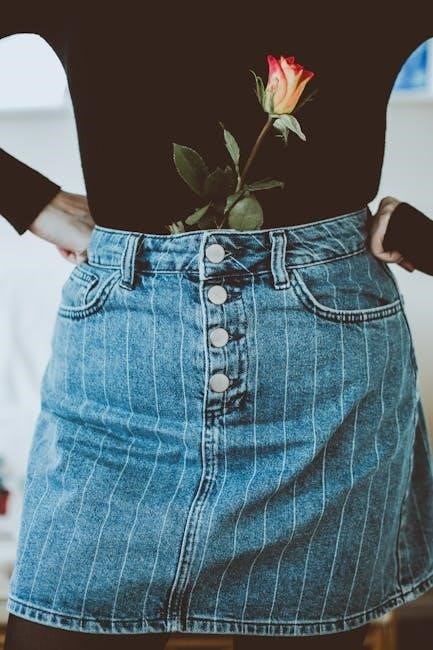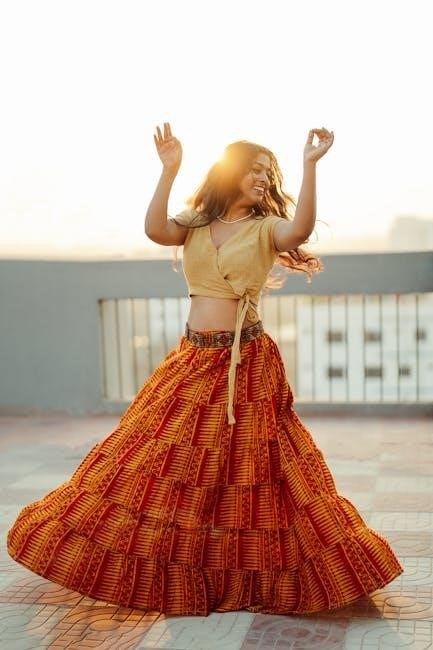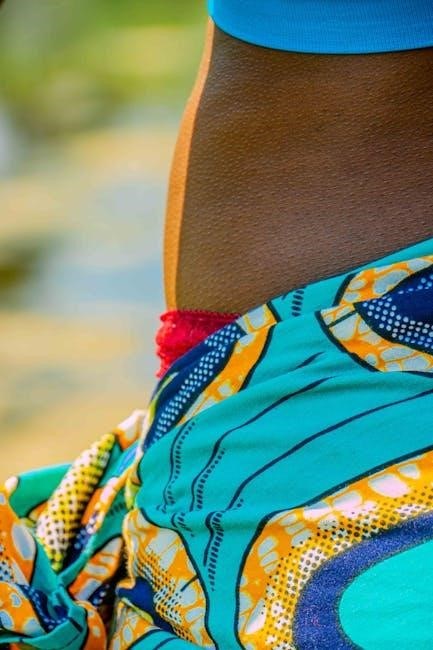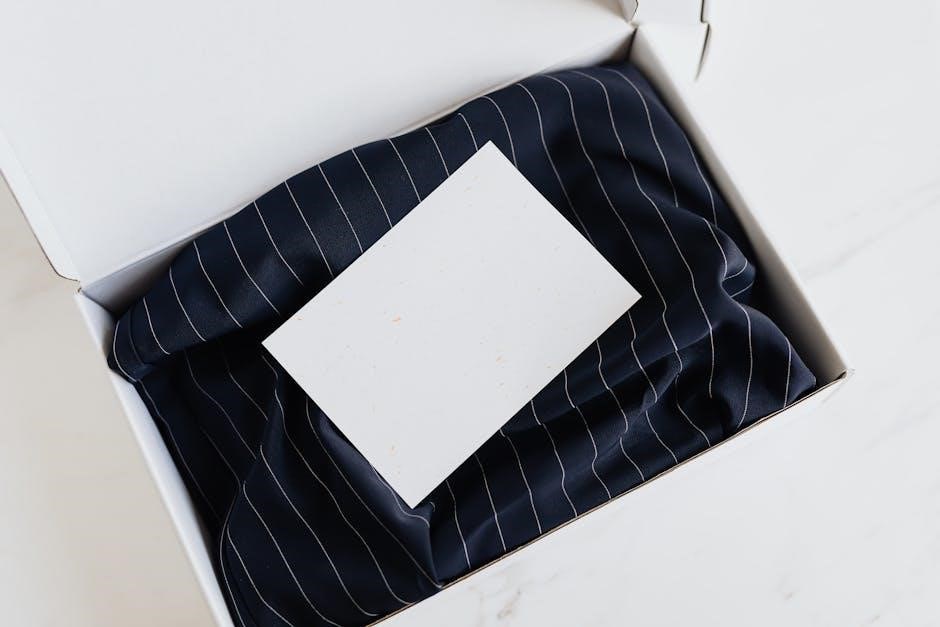Wrap skirt patterns offer a versatile and stylish sewing project, perfect for DIY enthusiasts. Free PDF patterns provide easy access to create custom, fashionable skirts with minimal effort.
1.1 Overview of Wrap Skirts and Their Popularity
Wrap skirts have gained immense popularity for their versatility, comfort, and timeless style. They offer a flattering fit for all body types, with designs ranging from mini to maxi lengths. The ease of creation, paired with free PDF patterns, has made them a favorite among DIY sewing enthusiasts. Their adjustable waistlines and customizable details allow for personalization, catering to diverse fashion preferences. This accessibility and adaptability have contributed to their widespread appeal, making wrap skirts a staple in many wardrobes and sewing projects.
1.2 Benefits of Using a PDF Pattern for Sewing
PDF patterns offer instant downloads, making them accessible anytime. They are scalable to various sizes without quality loss, and you can print only the needed pieces. Free options are budget-friendly, catering to all skill levels. Digital formats reduce paper waste, aligning with eco-conscious sewing. These features make PDF patterns a convenient and sustainable choice for DIY enthusiasts.
1.3 Importance of Free Resources for DIY Enthusiasts
Free resources for DIY enthusiasts are invaluable, offering accessibility to creative projects without financial barriers. They empower individuals to explore their creativity and learn new skills, fostering a sense of accomplishment. These resources, like the Luma, Tulip, and Patchwork Wrap Skirt patterns, provide detailed guides and inspiration. By sharing knowledge freely, communities grow, encouraging collaboration and innovation. Such accessibility ensures that DIY sewing remains inclusive and rewarding for all skill levels, promoting continuous learning and personal growth.

Understanding the Wrap Skirt Pattern
Free PDF wrap skirt patterns offer versatile designs, from mini to maxi styles. They include detailed instructions and measurements, ensuring a flattering fit for all body types easily.
2.1 History and Evolution of Wrap Skirts
Wrap skirts have roots in traditional clothing worldwide, with early versions appearing in cultures like African and Asian garments. The modern wrap skirt gained popularity in the 20th century, particularly in the 1970s, as a symbol of feminist independence. Originally designed for comfort and practicality, it evolved into a fashionable staple. The skirt’s timeless appeal lies in its versatility, suitable for casual and formal wear. Over time, variations like mini, midi, and maxi lengths emerged, catering to diverse styles and preferences, making it a beloved choice for sewists today.
2.2 Types of Wrap Skirts: Mini, Midi, Maxi
Wrap skirts come in various lengths to suit different styles and preferences. Mini wrap skirts are short and trendy, perfect for casual outings. Midi wrap skirts fall just above the knee, offering a balanced, elegant look. Maxi wrap skirts are floor-sweeping, ideal for formal events or bohemian-inspired outfits. Each style can be easily created using free PDF patterns, allowing sewists to customize their skirt according to fabric choice and personal taste.
2.3 Key Components of a Wrap Skirt Pattern
A wrap skirt pattern typically includes a front and back panel, waistband, and tie. Some designs feature pockets for added functionality. The pattern often includes hem allowances and seam margins. Accurate measurements ensure a proper fit, while markings guide fabric cutting. Optional details like lace trim or elastic waistbands enhance customization. Clear instructions outline assembly steps, from panel sewing to tie attachment. These components simplify the sewing process, making it accessible for all skill levels. Proper alignment and grain lines are crucial for a professional finish.

Materials and Tools Needed
To create a wrap skirt, you’ll need fabric (cotton or polyester), a sewing machine, scissors, measuring tape, and thread. Ensure you have a sewing kit handy.
3.1 Fabric Requirements for Different Styles
Fabric choice plays a crucial role in the look and feel of a wrap skirt. Lightweight fabrics like cotton, rayon, or silk are ideal for flowy, casual designs, while heavier materials such as denim or corduroy suit structured styles. Mini and midi skirts often use bold prints or bright colors for a trendy vibe, while maxi skirts benefit from soft, drapey fabrics like chiffon or jersey for elegance. Consider the season and desired comfort when selecting fabric;
3.2 Essential Sewing Tools for Making a Wrap Skirt
To create a wrap skirt, you’ll need a sewing machine, serger (optional), sharp scissors, a rotary cutter, and a mat for precise fabric cutting. A measuring tape, pins, and a seam ripper are also essential. Iron and ironing board are crucial for pressing seams and achieving a professional finish. Additionally, a zipper or waistband elastic may be required, depending on the pattern. Having these tools ensures a smooth and efficient sewing process for your wrap skirt project.
3.3 Measuring Tape and Sizing Guide
Accurate measurements are crucial for a perfect fit when using a wrap skirt pattern. Use a flexible measuring tape to record your waist, hips, and desired skirt length.
Refer to the sizing guide in the PDF pattern to match your measurements with the corresponding size. Ensure the tape is level and not too tight or loose. This step ensures your skirt fits comfortably and aligns with the pattern’s design specifications. Proper measurement prevents alterations and guarantees a professional finish.

Sizing and Measurement Guide
Accurate measurements are key for a perfect fit. Use a flexible tape measure to record waist, hips, and desired skirt length. Size charts in PDF patterns ensure proper sizing.
4.1 How to Take Accurate Body Measurements
To ensure a perfect fit, take measurements in a natural stance. Measure the waist at its narrowest point, hips 7-9 inches below the waist, and optional length for desired skirt height. Use a flexible tape measure, keeping it level and snug but not tight. For elasticated waistbands, consider adding ease for comfort. Double-check measurements to avoid errors. Accurate sizing ensures your wrap skirt drapes beautifully and fits seamlessly, regardless of the pattern or fabric chosen.
4.2 Understanding Size Charts in PDF Patterns
Size charts in PDF patterns are crucial for achieving a perfect fit. They typically include measurements like waist, hip, and length, ensuring the skirt suits your body type. Free patterns often offer multiple sizes, such as EU 32-56 or US 0-24, catering to various figures. Accurate measurements are key to selecting the right size, while elasticated waistbands provide comfort and flexibility. These charts simplify the process, making it easy to choose the ideal size for your custom wrap skirt, even for sewing beginners.
4.3 Adjusting the Pattern for a Perfect Fit
Ensure a flawless fit by comparing your measurements to the size chart. Adjust the pattern length, waistband, or seam allowances as needed. For curvier figures, add ease to the hips. Consider fabric type; stretchy materials may require smaller adjustments. Test adjustments by sewing a muslin prototype before cutting your final fabric. This step ensures comfort and a tailored look, making your wrap skirt truly personalized to your body shape and style preferences.

Step-by-Step Sewing Instructions
Cut fabric according to the pattern, sew panels together, and attach waistbands. Ensure proper alignment and secure seams for a professional finish. Ideal for beginners, this project is quick to complete.
5.1 Cutting Out the Fabric Pieces
Cutting fabric accurately is crucial for a professional finish. Print and assemble your PDF pattern, ensuring all pieces align properly. Use scissors or a rotary cutter to cut fabric according to the pattern markings. Lay fabric flat, pin pattern pieces securely, and cut along lines carefully. Double-check grain lines and notches for accuracy. For wrap skirts, cut two main panels and additional pieces like waistbands or ties. Handle delicate fabrics gently to avoid distortion. Precise cutting ensures a smooth sewing process and a well-fitted final garment.
5.2 Sewing the Skirt Panels Together
Once the fabric pieces are cut, align the skirt panels according to the pattern markings. Pin the sides and edges carefully to ensure proper alignment. Sew the panels together using a straight stitch, maintaining the recommended seam allowance. Press the seams flat to create a crisp finish. For accuracy, use a walking foot if available. Ensure the ties and waistband openings are properly secured during this step. Follow the PDF pattern instructions for specific stitching sequences to achieve a professional result.
5.3 Adding Waistbands and Ties
Adding waistbands and ties is a crucial step for a secure and stylish wrap skirt. Use a waistband pattern piece or cut a strip of fabric to fit your natural waist. Sew the waistband to the skirt top, folding raw edges under for a clean finish. Ties can be made from matching fabric or contrasting material for a decorative touch. Sew ties separately, then attach them to the waistband ends. Ensure ties are long enough to wrap around and tie comfortably. Topstitch for a professional look and durability.
5.4 Hemming the Edges for a Professional Finish
Hemming the edges of your wrap skirt is essential for a polished look. Fold the fabric twice to create a narrow hem, then sew in place using a straight stitch. Backstitch at the beginning and end for security. Press the hem with an iron to create a crisp fold. For a more professional finish, consider hand-stitching the hem for an invisible seam. This step ensures durability and prevents fraying, giving your skirt a high-quality appearance.
Customization and Embellishments
Personalize your wrap skirt with unique details like pockets, decorative trims, or contrasting fabrics to create a one-of-a-kind piece that reflects your personal style perfectly.
6.1 Adding Pockets to Your Wrap Skirt
Add functionality and style to your wrap skirt by incorporating pockets. This customization enhances practicality while maintaining elegance. Use the free PDF pattern as a guide to seamlessly integrate side or patch pockets into your design. Position them symmetrically for a balanced look, ensuring easy access. For a polished finish, align the pocket edges with the skirt’s seams. Consider using contrasting fabric for a decorative touch or match the skirt fabric for a subtle appearance. This feature is perfect for daily wear, offering both charm and convenience.
6.2 Incorporating Lace or Trim Details
Incorporating lace or trim into your wrap skirt adds a touch of elegance and personal style. Choose lace that complements your fabric, and apply it along hemlines or seams for a decorative finish. Trim can be used to create subtle accents or bold statements, depending on your design preference. Free PDF patterns often include options for adding these embellishments, making it easy to customize your skirt. Experiment with different materials and placements to achieve the desired aesthetic for your unique wrap skirt creation.
6.3 Using Different Fabrics for Unique Looks
Experimenting with fabrics adds personality to your wrap skirt. Cotton and linen offer a casual, breathable look, while chiffon or silk create a flowy, elegant appearance. Velvet or corduroy add texture for a seasonal vibe. Mixing patterns like polka dots or florals with solids can create a distinctive style. Free PDF patterns often include fabric recommendations, ensuring the perfect drape and fit. By choosing unique fabrics, you can tailor your skirt to suit any occasion, from everyday wear to special events, making it truly one-of-a-kind.
Troubleshooting Common Issues
Address uneven hems, adjust waistbands for comfort, and resolve fabric stretch or gather issues with quick fixes and expert tips for a flawless wrap skirt finish.
7.1 Fixing Uneven Hems or Seams
Uneven hems or seams can occur due to fabric shifting or improper pinning. To fix this, re-pin the fabric, ensuring alignment. Use a walking foot for even feeding. If noticeable, hand-baste the area before sewing. For minor discrepancies, topstitch carefully. Resources like the DIY wrap skirt tutorial offer tips to achieve professional-looking hems. Adjusting your technique and using the right tools can prevent future issues, ensuring a smooth, polished finish for your wrap skirt.
7.2 Adjusting the Waistband for Comfort
Ensuring a comfortable waistband is crucial for a wrap skirt. Free PDF patterns often include elasticated or ties options. For elasticated waistbands, measure accurately and adjust the length for a snug fit. For tie waistbands, ensure ties are long enough to wrap around comfortably. Some patterns allow for adding darts or shirring for extra comfort. These adjustments ensure a flattering and relaxed fit, making the skirt wearable for extended periods. Proper customization enhances both aesthetics and practicality.
7.3 Resolving Fabric Gather or Stretch Issues
Fabric gather or stretch issues can affect the fit and appearance of your wrap skirt. To resolve this, ensure accurate measurements and use the correct stretch percentage for knits. Adjusting seam allowances or adding stabilizer can prevent distortion. For puckering, check thread tension and press seams carefully. If fabric stretches unevenly, consider interfacing or lining for stability. Properly following the pattern’s sizing guide and instructions will help achieve a balanced, professional finish without compromising comfort or style.
Finished Project Showcase
Discover stunning examples of wrap skirts made using free PDF patterns. See the Luma and Tulip skirts, styled effortlessly for casual or elegant looks, and share your creations online.
8.1 Examples of Wrap Skirts Made from Free PDF Patterns
Popular free PDF patterns like the Tulip and Luma Wrap Skirts offer stylish designs. The Tulip features a flared silhouette, while the Luma boasts a knee-length fit with an elastic waist. Both patterns cater to various skill levels, making them ideal for DIY projects. These examples highlight how free PDF patterns can create trendy, customizable skirts with minimal effort, encouraging sewists to experiment with fabrics and embellishments for unique looks.
8.2 Styling Tips for Wearing Your Wrap Skirt
Wrap skirts are versatile and can be styled for various occasions. Pair a mini wrap skirt with tights and boots for a chic winter look, or go for a midi style with a cozy sweater. Maxi wrap skirts are perfect for a bohemian vibe, layered with a jacket or cardigan. Add a belt to define your waist or accessorize with a statement brooch. For a polished look, hem the edges neatly and consider adding pockets for functionality. Experiment with fabrics and details to create a unique, personalized outfit.
8.3 Sharing Your Project on Social Media
Sharing your finished wrap skirt on social media is a great way to showcase your creativity. Use hashtags like #WrapSkirtPattern or #DIYSewing to connect with enthusiasts. Post high-quality photos of your skirt.
Popular Wrap Skirt Patterns Available for Free
Discover free PDF patterns like the Luma Wrap Skirt, Tulip Wrap Skirt, and Patchwork Wrap Skirt, offering versatile designs for all skill levels and preferences.
9.1 Luma Wrap Skirt Pattern
The Luma Wrap Skirt Pattern is a popular choice for DIY enthusiasts, offering a beginner-friendly design with a stylish belt detail. Available as an instant download PDF, it caters to a wide range of sizes (EU 32-56, US 0-24), making it inclusive for sewists of all levels. The pattern is ideal for a quick sewing project, allowing you to create a chic mini wrap skirt with a professional finish. Its simplicity and versatility make it a favorite among those looking for a hassle-free yet fashionable sewing experience.
9.2 Tulip Wrap Skirt Pattern
The Tulip Wrap Skirt Pattern is a popular choice for DIY sewing enthusiasts. Designed for all skill levels, it offers a timeless, elegant design with a flared silhouette. Available as a free PDF download, it includes adjustable waist ties and optional pockets for added convenience. Suitable for various fabrics, from lightweight materials to heavier textiles, this pattern ensures a customizable fit. Clear instructions guide sewists through each step, making it ideal for both beginners and experienced makers seeking a versatile wardrobe staple.
9.3 Patchwork Wrap Skirt Pattern
The Patchwork Wrap Skirt Pattern combines creativity and practicality, offering a unique, customizable design. Perfect for fabric scraps, it creates a vibrant, one-of-a-kind piece. Available as a free PDF, this pattern guides you through piecing together contrasting fabrics into a cohesive wrap skirt. Its rustic charm and versatility make it ideal for DIY enthusiasts seeking a personalized wardrobe staple. Measurements and styling tips are included for a tailored fit and versatile looks.
Creating a wrap skirt using a free PDF pattern is a rewarding DIY project. With versatile designs and easy customization, it offers endless possibilities for personal style and creativity.
10.1 Final Thoughts on Sewing a Wrap Skirt
Sewing a wrap skirt is a rewarding project that combines creativity with practicality. With free PDF patterns readily available, DIY enthusiasts can effortlessly create stylish, customizable skirts. Whether you’re a beginner or an experienced sewer, the process is straightforward and quick, allowing for a sense of accomplishment. Experimenting with fabrics, lengths, and embellishments adds personal touches, making each skirt unique. The versatility of wrap skirts ensures they can be dressed up or down, making them a versatile addition to any wardrobe. Give it a try and enjoy the satisfaction of wearing your handmade creation!
10.2 Encouragement to Try the Pattern
Embrace the joy of sewing with a free wrap skirt PDF pattern! Perfect for beginners, these patterns offer a quick and rewarding project. With easy-to-follow instructions and versatile designs, you can create a stylish, custom skirt in no time. The sense of accomplishment from making something yourself is unbeatable. Don’t hesitate to give it a try—whether you’re a seasoned sewer or just starting out, you’ll love the process and the result. Happy sewing, and enjoy creating your unique wrap skirt today!
10.3 Resources for Further Learning
Explore sewing blogs, YouTube channels, and social media for tutorials and tips. Websites like Pinterest and Instagram offer inspiration and guides for wrap skirts. Join sewing communities to share ideas and learn from experts. Free PDF patterns from designers and platforms provide additional projects to practice. Check out the Tulip Wrap Skirt and Luma Wrap Skirt patterns for more variations. Online courses and sewing forums can deepen your skills and help troubleshoot common issues.